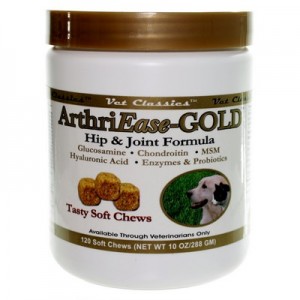According to a recent study, more than two-thirds of the people suffering from some form of arthritis are over the age of 65. In other words, arthritis is predominately a gerontic disease, or one that affects the elderly disproportionately. But even this definition is inadequate. The fact is just about every active species on Earth suffers from the disorder. Paleontologists have discovered evidence of osteoarthritis, the most common type of the disease, in dinosaurs. Homo sapiens have been documenting cases of arthritis for nearly seven thousand years now. How about our furry friends?
Because they cannot complain about their pain, cases of feline and canine arthritis have gone untreated since prehistory. There is little doubt dogs and cats have been suffering from the disease since they were first brought into human settlements. Because they are bigger and they age at a slightly faster rate, canines are more likely to be diagnosed with arthritis than their feline counterparts. According to some estimates, about twenty percent of adult dogs suffer from some form of the disease.
The most common cause of chronic arthritis in dogs is inflammation, which is caused by infection or biomechanics and is almost always degenerative, i.e., it gets worse over time. In most cases, pain and discomfort occur because there is not enough cartilage surrounding and protecting the moving joints. When these sensitive, connective, and unprotected bones rub together, the patient invariably experiences discomfort or even acute pain.
Most of dogs diagnosed with arthritis have osteoarthritis, which is often purely mechanical. Degraded and deteriorating joints cause pain because of cartilage loss, and the patient simply cannot move around like he/she used to. Natural consequences of decreased physical activity include weight gain, lethargy, chronic muscle injuries, and depression. Yes, your pet dog can become depressed if unable to enjoy an active lifestyle.
What are the symptoms of arthritis in dogs?
An animal with arthritis will find it more difficult to perform almost every activity, from running and jumping to walking up the stairs or even sitting and standing. Anything putting additional pressure on joints will hurt and thusly will be avoided as the disease progresses. Fortunately, the chronic condition can be treated, but not cured. Just like their people, pets respond to pain-relieving drugs known as analgesics. Depending on the degree of degeneration, your dog’s doctor may prescribe a number of medications designed to increase comfortable and manage pain in your dog. These tablets and pills are more than mere stopgap solutions, they can actually help him recover and build up his strength a bit.
Treatment Options for Arthritis in Dogs
OroCam (meloxicam) is Now Available at VetRxDirect
Novox (carprofen) Caplets: A non-steroidal anti-inflammatory prescription medication, Novox (carprofen) helps relieve pain and inflammation in dogs suffering from chronic arthritis. Lab tests and studies have returned mostly positive results and few negative side effects. The most common corollary is a simple stomach ache that may eventually lead to ulcers. It is for this reason that the medication should always be given with your pet’s favorite food. Dog lovers should do their best to administer Novox (carprofen) caplets once a day at the same time each day, which may greatly reduce the risk of potential side effects.
 ArthriEase-GOLD: A popular supplement with humans, glucosamine, one of the primary ingredients in ArthriEase-GOLD, helps promote joint tissue health. This product also includes chondroitin sulfate used to improving symptoms of arthritis, hyaluronic acid which acts like a cushion and lubricant for joints, and MSM (methylsulfonylmethane) used to help control pain.
ArthriEase-GOLD: A popular supplement with humans, glucosamine, one of the primary ingredients in ArthriEase-GOLD, helps promote joint tissue health. This product also includes chondroitin sulfate used to improving symptoms of arthritis, hyaluronic acid which acts like a cushion and lubricant for joints, and MSM (methylsulfonylmethane) used to help control pain.
Once again, most forms of arthritis are degenerative. They will get worse over time. But with the right prescription medications and supplements, it is possible to alleviate joint and muscle pain in our pets. Affordable and relatively easy to administer, all of the medications we discussed today may improve the quality of your dog’s life and allow your pet to live out the remaining years in fine fettle.

